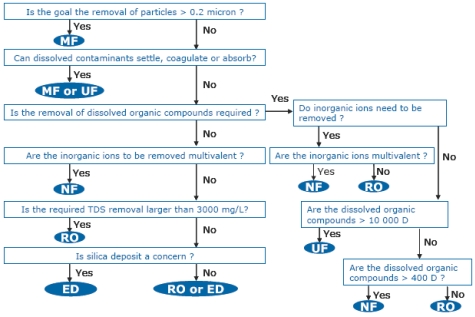Hybrid technologies: examples of applications Water purification and reuse Implementation of membranes in the water cycle includes drinking and process water production, industrial process and wastewater treatment, municipal sewage treatment, product recovery from aqueous streams, water loop closure, and treatment of groundwater, agricultural waste streams or percolation waters. |
Contaminants are usually present in low concentrations and in mixtures. Moreover, waste streams are usually low value products. The choice for a treatment technique depends on its economic and technical feasibility. When membrane processes are concerned, they should thus be capable to accomplish the desired separation, either as stand alone technique or in combination with other treatment processes. Low-pressure membrane technologies (MF/UF) are recognized as very attractive processes for producing drinking water from groundwater or surface water. Particularly UF can be applied for water disinfection as it achieves excellent removal of bacteria, pathogens such as Giardia, and even viruses. |
 |
In addition, it is perfectly suited to eliminate particles (suspended solids or micro-organisms).When combined with powder activated carbon addition, it can be used to treat groundwater contaminated by micropollutants such as pesticides. As an alternative, NF has been considered for the production of high-quality drinking water, as it leads to very efficient removal of natural organic matter (NOM), a precursor of disinfection byproducts. Drinking water can also be produced by brackish or seawater desalination. In this area, RO and also ED are applied at large scale. Depending on the feedwater quality, various pre-treatment schemes are implemented, in which UF may play a role. Market drivers for the implementation of membranes in wastewater treatment, are the need to meet regulations for discharge standards and the implementation of water reuse. MBRs are mostly considered when stringent discharge standards have to be met, when space is limited and when plant capacity has to be increased. When water reuse is a driver as in many industrial environments, an additional advantage comes from the fact that the permeate can be subjected to sensitive posttreatment technologies such as RO, without additional pre-treatment. MBRs therefore often form the core of water reuse schemes. As membranes can achieve a higher treatment standard than conventional processes, they are often implemented to upgrade wastewater quality by removing particulates (MF/UF) and dissolved substances such as salts and dissolved organics (NF/RO). When applied on process streams, the aim may either be to purify the water stream, to concentrate and recover the pollutant or occasionally to achieve both. Examples are the removal of heavy metals from electroplating rinse waters by ED and the removal of volatile organic pollutants from water by pervaporation. As industry is faced with increasing problems of water supply and increasing costs of wastewater discharge, alternative sources of process water are searched for. Wastewater is a potential source but requires regeneration before it can be recycled as e.g. industrial process water or cooling tower makeup water. Membrane technology is often implicated in such water loop closure schemes. Numerous examples exist in many industrial sectors and have been documented in literature. One arbitrarily chosen case study is the Pasfrost vegetable processing plant in Belgium. The company implemented water saving measures such as partial reuse of wash water for low-grade applications and extended wastewater treatment to produce a more stable effluent suitable for reuse. After a two step anaerobicaerobic biological purification step, the effluent is subjected to coagulation/sand filtration. Then, the flow is directly reused for second–grade operations after a disinfection step or pumped to a two-stage RO with UF pre-treatment. After an additional UV disinfection, a sterile process water is obtained for reuse. The introduction of this reuse scheme allowed the company to limit its groundwater consumption. Investment and energy consumption costs were lower than for the alternative of evaporation. Water reuse is evidently not only considered in industry, but is also implemented for potable water production. The multibarrier approach for safe drinking water production usually involves a combination of membrane fi ltration and disinfection. Well-known examples are the production of NeWater in Singapore, direct potable reclamation in Windhoek, Namibia for over 40 years, and the Torreele plant in Belgium where MBR + RO permeate generated from municipal effl uent is infi ltrated in a dune water catchment area. It is important to note though that discharge of concentrate streams from membrane separation processes may prohibit the implementation of advanced reuse schemes. |